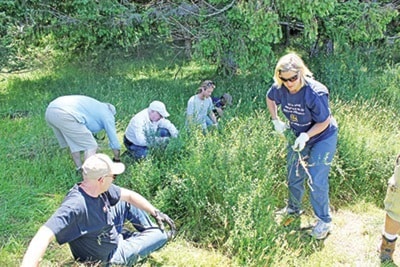More than a dozen Broom bashers gathered at the foot of Mills Street in Parksville where they heard from Doug Herchmer, a Nature Trust of B.C. volunteer warden who explained the work they have already done to rehabilitate the area known as Parksville Flats.
He said at one time the estuary was completely covered in Scotch Broom posing a huge threat to the native plants which are crucial for the wildlife that call the estuary home.
He said many volunteers, including a Katimavik crew, have cleared a lot of Broom in the area. but despite their efforts there are still remnants of the weed.
He said they also planted native trees in the area but after two straight summers of dry weather a lot of them died.
“It is difficult to get trees established because of drought and deer. You have to plant species that like to grow here and it is a function of moisture,” he pointed out.
Herchmer said Broom is a strong competitor with native plants, including newly planted coniferous forests and that is why they want to get rid of it.
“I wish people would take it more seriously and pull Broom on their own property,” he confessed.
The Broom patch the volunteers at the Englishman River Estuary were pulling was young and not blooming which according to Herchmer is even harder to get rid of than the giant ones.
“This is a really nasty patch. It is labour intensive because you have to get on your hands and knees to get at it.”
The estuary is managed by the Vancouver Island Conservation Program in partnership with the Ministry of Forests, Lands & Natural Resource Operations, Ducks Unlimited Canada, the Nature Trust of B.C., the RDN and the Habitat Conservation Trust Foundation.
According to the information board at the entrance to the estuary the site is a safe harbour for millions of migratory birds and each year more than 250 species of birds have been reported in the area.
